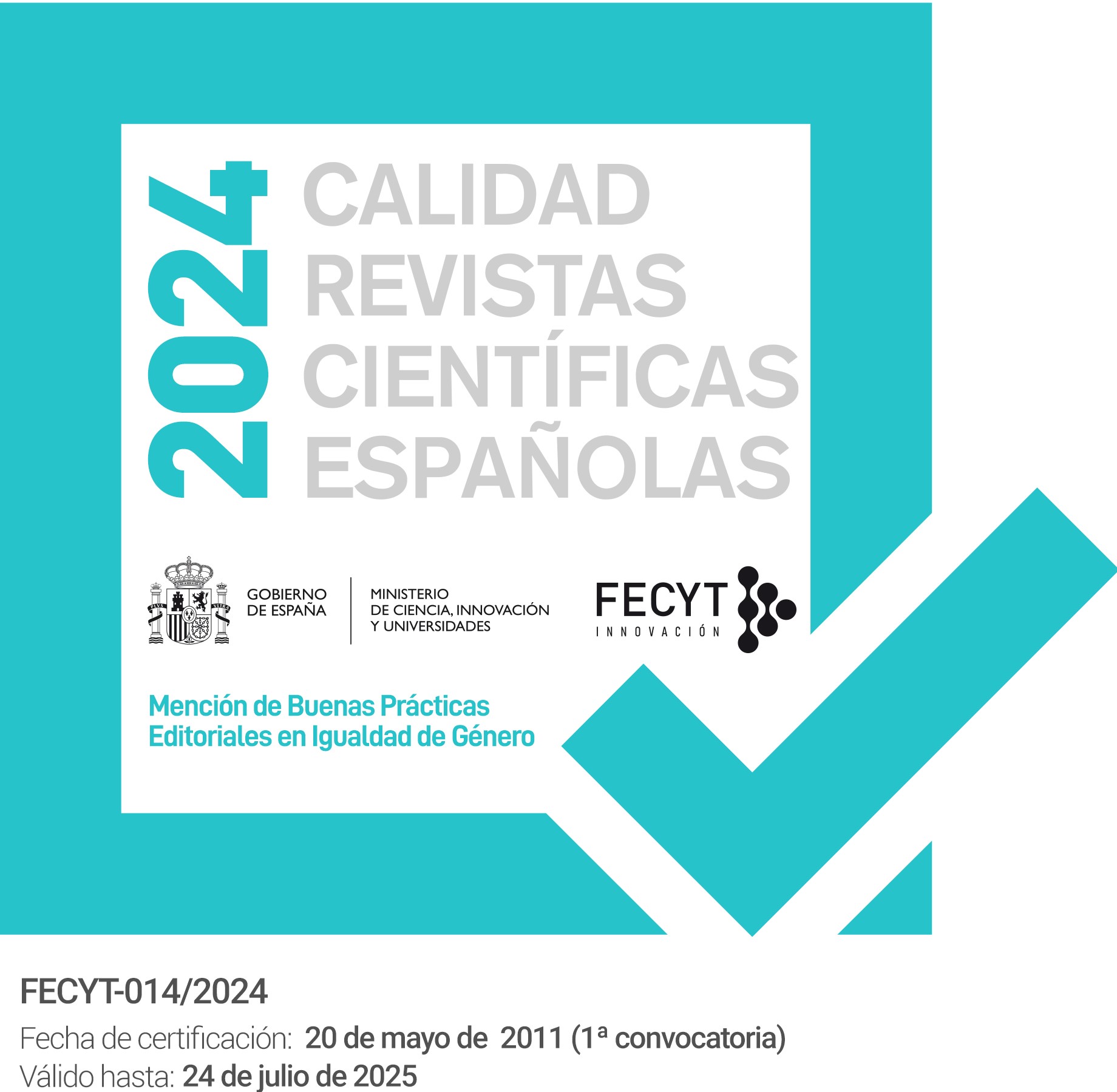La integración cultural y social en las migraciones intraeuropeas
Palabras clave:
Migraciones, Competencia intercultural, Orientación cultural, Integración social, Adaptación psicológica.Resumen
Cuando un migrante llega a una sociedad distinta, debe elegir cómo vivir en ella. En esta elección cuentan su pasado, su presente y especialmente su futuro en términos de expectativas de movilidad. Comprender cómo viven los residentes extranjeros en su país de destino implica considerar conceptos clave como procesosde socialización, shock cultural, competencia intercultural o procesos de aculturación que implican aprender nuevas competencias culturales. A partir de los datos de la Encuesta Social de Migraciones Internas Europeas (EIMSS) este trabajo se centra en el análisisde dos dimensiones, la integración cultural y la integración social, que van a caracterizar el modo en que los migrantes europeos vivenen su nuevo entorno social, y su relación con la percepción de ladiscriminación que tiene el migrante o su adaptación psicológica,en términos de nostalgia y satisfacción con la vida.Descargas
Citas
ALBERT, M. C. (2007): Aculturación y competencia intercultural: presupuestos teóricos y modelos empíricos. Alicante: Publicaciones Universidad de Alicante.
ALBERT, M. C., y MASANET, E. (2008): «Los matrimonios mixtos en España ¿espacios de construcción intercultural?». Obets. Revista de Ciencias Sociales 1, 45-71.
ANTHIAS, F. (1992): Ethnicity, Class, Gender and Migration: Greek Cypriots in Gran Bretaña. Avebury: Aldershot.
ANWAR, M. (1979): The Myth of Return: Pakistanis in Great Britain. London: Heinemann.
BALDONI, E. (2008): «Guardando ad Est: questioni di identità nelle coppie miste di italiani, polacche e rumene». Obets. Revista de Ciencias Sociales 1, 91-117.
BARONA, A., y MILLER, J. A. (1994): «Short acculturation scale for Hispanic youth (SASHY): A preliminary report». Hispanic Journal of Behavioral Sciences 16, 155-162.
BERRY, J. W. (1970): «Marginality, stress, and ethnic identifi cation in an acculturated Aboriginal community». Journal of Cross-Cultural Psychology 1, 17-22.
— (1997): «Immigration, acculturation and adaptation». Applied Psychology: An International Review 46, 5-34.
BERRY, J. W. (2003): «Conceptual approaches to acculturation», en K. M. CHUN, P. BALLS-ORGANISTA, y G. MARIN (eds.), Acculturation: Advances in theory, measurement, and applied research, Washington DC: American Psychological Association, pp. 17-34.
BONACICH, E. (1973): «A Theory of Middleman Minorities». American Sociological Review, 38, 583-594.
BRAUN, M. (2010) «¿Son diferentes las migraciones circulares? La integración, el bienestar y la intención de quedarse de los que migran por primera vez y de los migrantes circulares». Obets. Revista de Ciencias Sociales 5 (2), 201-220.
CHUN, K. M.; BALLS-ORGANISTA, P., y MARIN, G. (eds.) (2003): Acculturation: Advances in theory, measurement, and applied research. Washington DC: American Psychological Association.
CLARK, M.; KAUFMAN, S., y PIERCE, R. (1976): «Explorations of Acculturation: Toward a model of ethnic identity». Human Organization, 35, 231-238.
COLLINSON, S. (1993): Europe and International Migration. London: Pinter Publishers.
CORTES, D.; ROGLER, L., y MALGADY, R. (1994): «Biculturality among Puerto Ricans in the United States». American Journal of Community Psychology 22, 707-715.
CUÉLLAR, I.; ARNOLD, B., y MALDONADO, R. (1995): «Acculturation rating scale for Mexican-Americans-II: A revision of the original ARSMA scale». Hispanic Journal of Behavioral Sciences 17, 275-403.
CUELLAR, I.; HARRIS, L. C., y JASSO, R. (1980): «An acculturation scale for Mexican American normal and clinical populations». Hispanic Journal of Behavioral Sciences 2 (3), 199-217.
DAWSON, E. J.; CRANO, W. y BURGOON, M. (1996): «Refi ning the meaning and measurement of acculturation: revisiting a novel methodological approach». International Journal of Intercultural Relations 20 (1), 97-114.
ESSER, H. (2003): «What substance is there to the term ‘Leitkultur’?», en R. CUPERUS, K. A. DUFFEK y J. KANDEL (Eds.), The challenge of diversity. European social democracy facing migration, integration and multiculturalism. Innsbrück/Vienna: Studienverlag, pp. 47-58.
GARCIA, M., y LEGA, L. I. (1979): «Development of a Cuban Ethnic Identity Questionnaire». Hispanic Journal of Behavioral Sciences 1, 247-261.
GRAVES, T. D. (1967): «Psychological acculturation in a tri-ethnic community». Southwestern Journal of Anthropology 23, 337-350.
GHUMAN, P. A. (1991): «Best or worst of two worlds? A study of Asian adolescents». Educational Research 33 (2), 121-132.
HECKMANN, F. (2001): «Integrationsforschung aus Europäischer Perspektive». Zeitschrift für Bevölkerungswissenschaft 26 (3-4), 341-356.
HOFSTEDE, G. (2001): Culture’s Consequences, Comparing Values, Behaviors, Institutions, and Organizations Across Nations Thousand Oaks. CA: Sage Publications.
HOFSTEDE, G. (2003): Cultures and Organizations: Software of the Mind: intercultural Cooperation and Its Importance for Survival. New York: McGraw-Hill.
IBAÑEZ, M. (2009): «Procesos migratorios desde Europa Central y del Este en España: estatus jurídico, identidad social e inserción laboral». Revista CIDOB d’afers internacionals 84, 105-152.
ISAJIW, W. W. (1997): «On the concept of social incorporation», en W. W. ISAJIW (ed.), Multiculturalism in North America and Europe: Comparative perspectives on interethnic relations and social incorporation. Toronto: Canadian Scholar Press, pp. 79-102.
KELLY, J. G.; AZELTON, L. S.; BURZETTE, R. G., y MOCK, L. O. (1994): «An ecological thesis: Creating social settings for diversity», en E. J. TRICKETT, R.J. WATTS y D. BIRMAN (eds.), Human diversity: Perspectives on people in
context. San Francisco: Jossey-Bass, pp. 421-451.
LANDRINE, H., y KLONOFF, E. A. (1994): «The African American Acculturation Scale: development, Reliability, and Validity». Journal of Black Psychology 20 (2), 104-127.
LÓPEZ, B., y PEREA, I. (2008): «Nota metodológica sobre el estudio socialización, aculturación y competencia intercultural: un análisis empírico de familias multiculturales». Obets. Revista de Ciencias Sociales 2, 83-89.
MARIN, G.; SABOGAL, F.; MARIN, B.; OTERO-SABOGAL, R., y PÉREZ-STABLE, E. (1987): «Development of a short acculturation scale for Hispanics». Hispanic Journal of Behavioral Sciences 9, 183-205.
MARTÍNEZ, M. C.; PATERNA, C.; LÓPEZ, J. A., y MARTÍNEZ, J. (2007): «Autoestima colectiva y aculturación en inmigrantes ecuatorianos». Apuntes de Psicología 25 (1), 67-78.
MARTÍNEZ, M. M.; SIMPSON-HOUSLEY, P., y DE MAN, A. (1992): «Características de la personalidad e integración de los emigrantes españoles en Toronto (Canadá)». Anales de Psicología 8 (1-2), 71-75.
NWADIORE, E., y MCADOO, H. (1996): «Acculturative stress among American refugees: Gender and racial differences». Adolescence 3, 477-487.
O’REILLY K. (2000): The British on the Costa del Sol: Transnational Identities and Local Communities. New York: Routledge.
PADILLA A. M. (ed.) (1980): Acculturation: Theory, models and some new fi ndings. Boulder, CO: Westview.
PORTES, A., y RUMBAUT, R. (2001): Legacies. The Story of the Immigrant Second Generation. Berkeley: University of California Press.
PORTES, A., y ZHOU, M. (1993): «The new second generation: segmented assimilation and its variants». Annals of the AAPSS 530, 74-96.
RECCHI, E., y FAVELL, A. (eds.): (2009): Pioneers of European Integration: citizenship and mobility in the EU. Cheltenham: Edward Elgar.
REDFIELD, R.; LINTON, R., y HERSKOVITS, M. J. (1936): «Memorandum for the study of acculturation». American anthropologist 38, 149-152. RYDER, A. G.; ALDEN, L. E., y PAULHUS, D. L. (2000): «Is acculturation unidimensional or bidimensional? A head-to-head comparison in the prediction of personality, self-identity, and adjustment». Journal of Personality and Social Psychology 79, 49-65.
SÁNCHEZ, J. I., y FERNÁNDEZ, D. M. (1993): «Acculturative Stress Among Hispanics: A Bidimensional Model of Ethnic Identifi cation». Journal of Applied Social Psychology, 23 (8), 654-668.
SANTACREU, O.; ROTHER, N., y BRAUN, M. (2006): «Stichprobenziehung für Migrantenpopulationen in fünf Ländern: Eine Darstellung des methodischen Vorgehens im PIONEUR-Projekt». ZUMA-Nachrichten 59, 72-88.
SCHMITZ, P. G. (1992): «Acculturation styles and health», en S. IWAWAKI, Y. KASHIMA y K. S. LEUNG (eds.), Innovations in cross-cultural psychology. Amsterdam: Swets & Zeitlinger, pp. 360-370.
SCHOORL, J. (2005): «Information needs on stocks of migrants for research on integration». UNECE/Eurostat Seminar on Migration Statistics. Working Paper n.º 5 Rev. 1. Consultado el 12 de enero de 2009 en http://www.unece.org/stats/documents/2005/03/migration/wp.5.e.pdf
SEARLE, W., y WARD, C. (1990): «The prediction of psychological and sociocultural adjustment during cross-cultural transitions». International Journal of Intercultural Relations 14, 449-464.
SUINN, R. M.; KHOO, G., y AHUNA, C. (1995): «The Suinn-Lew Asian Self-Identity Scale: Cross-cultural information». Journal of Multicultural Counseling and Development 23, 139-148.
SZAPOCZNIK, J., KURTINES, W., y FERNANDEZ, T. (1980): «Bicultural involvement and adjustment in Hispanic-American youths». International Journal of Intercultural Relations 4, 353-365.
TAYLOR D. M., y LAMBERT W. E. (1996): «The meaning of multiculturalism in a culturally diverse urban American area». Journal of Psychology 136, 727-740.
TESKE, R. H. C., y NELSON, B. H. (1974): «Acculturation and Assimilation». American Ethnologist 1 (2), 351-368.
THOMAS, W. I., y ZNANIECKI, F. (1921): The Polish Peasant in Europe and America. Chicago: The University of Chicago Press.
TRIANDIS, H. C.; LISANSKY, J.; SETIADI, B.; CHANG, B.; MATIN, G., y BETANCOURT, H. (1982): «Stereotyping among hispanics and anglos: The uniformity, intensity, direction, and quality of auto and hetereostereotypes». Journal of Cross-Cultural Psychology 13, 409-426.
URIELY, N. (1994): «Rhetorical Ethnicity or Permanent Sojourners: The Case of Israeli Immigrants in the Chicago Area». International Sociology 9 (4), 431-445.
WARD, C., y KENNEDY, A. (1994): «Acculturation strategies, psychological adjustment, and sociocultural competence during cross-cultural transitions». International Journal of Intercultural Relations 18, 329-343.
WARD, C. (1996): «Acculturation», en D. LANDIS y R. BHAGAT (eds.), Handbook of intercultural training (2.ª ed.): Thousand Oaks, CA: Sage, pp. 124-147.
— (2001): «The ABCs of acculturation»., en D. MATSUMOTO (ed.), Handbook of culture and psychology. New York: Oxford University Press, pp. 411- 445.
ZAK, I. (1973): «Dimensions of Jewish-American identity». Psychological Reports 33, 891-900.
ZARZA, M. J., y SOBRINO, M. I. (2007): «Estrés de adaptación sociocultural en inmigrantes latinoamericanos residentes en Estados Unidos vs. España: una revisión bibliográfi ca». Anales de Psicología 23 (1), 72-84.
ZLOBINA, A.; BASABE, N., Y PÁEZ, D. (2008): «Las estrategias de aculturación de los inmigrantes: su signifi cado psicológico». Revista de Psicología Social 23 (2), 143-150.
Descargas
Publicado
Cómo citar
Número
Sección
Licencia
Los autores de artículos aceptados en la revista Migraciones conservan los derechos de propiedad intelectual sobre sus trabajos y otorgan a la revista los permisos de distribución y comunicación pública de los mismos, consintiendo que se publiquen bajo una licencia Creative Commons NonCommercial-NoDerivatives-Attribution 4.0 International License. Se recomienda a los autores publicar su trabajo en Internet (por ejemplo en páginas institucionales o personales, repositorios, etc.) respetando las condiciones de esta licencia y citando debidamente la fuente original.






